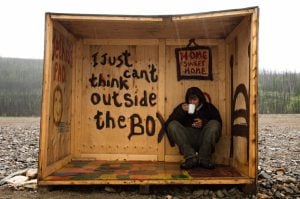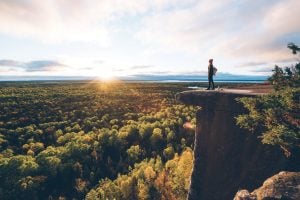
Travel
The spell of the Yukon
An insider’s account of the modern-day gold rush
- 4210 words
- 17 minutes
This article is over 5 years old and may contain outdated information.
People & Culture

I’m hunched over a tea-coloured Klondike stream with a large metal dish in my hands, swirling grey river gravel around in a motion that, I’m told, settles gold at the bottom and washes away everything else. It turns out panning is backbreaking work, and pretty soon I roll back on my haunches to watch Bonanza Creek sluice back and forth between the valley’s rounded slopes. I picture a swarthy prospector crouched by this birch-lined stream, dreaming of the mother lode and slowly filling a beaded moose-hide poke tied to his belt. I can understand the allure, but it’s not sexy work. After an hour of staring at a muddy pan and several false alarms, my twin five-year-old daughters and I eventually isolate a golden fleck and stash it in a glass vial. On our way back to the car, the girls charm a tour bus driver who pulls his own vial from his breast pocket and shakes some glittering gold flakes onto our meagre find. If only striking it rich were so easy.
We’re just upstream from Discovery Claim, a 15-minute drive south of Dawson, Y.T., where either a Tagish First Nation man named Keish (better known as Skookum Jim) or one of his three companions found gold lying between flaky slabs of rock, like “cheese in a sandwich,” in August 1896. News of the strike sparked the famous Klondike gold rush that lured thousands of fortune seekers and turned tiny Dawson into a northern metropolis surrounded by tent encampments. Writers such as Jack London, Pierre Berton and Charlotte Gray have explored the drama that unfolded during that era, but these “gold fever!”-type stories of prospectors, lawmakers, lawbreakers and rowdy saloons have tended to overshadow the rich history and traditions of the Yukon’s First Nations.

But that’s changing. Since the late 1990s, when the Yukon celebrated a series of centennials, including the big Klondike strike, the RCMP’s presence in the territory and entry into Confederation, First Nations people have been pulling their stories out from the shadow of the gold rush and presenting their heritage with a burst of pride. Five cultural centres have opened across the territory in the last decade, and the First Nations art and performance scene has exploded. My daughters are even learning how to speak Southern Tutchone at their Whitehorse school. All of which explains why we have just spent a week cruising the Klondike Highway from Carcross to Dawson in an RV: gold panning notwithstanding, we want to witness the revival of these traditions ourselves.
Keith Wolfe-Smarch grins and points to a book lying open to an archival photo of Skookum Jim’s nephew, Patsy Henderson, who was with his uncle when he struck it rich, dressed in beaded and fringed moose hide regalia and standing tall for the camera. “That’s what I’m doing,” he says. “I’m welcoming visitors to Carcross and sharing my culture.”
Wolfe-Smarch is a renowned Tagish-Tlingit master carver who spends most of his days in the new riverfront Carcross/ Tagish First Nation carving studio, which isn’t far from where Henderson, trading on his gold rush celebrity, used to greet visitors arriving on the White Pass & Yukon Route trains, which chugged over the mountain pass, until his death in 1966 at age 87. Here, Wolfe-Smarch mentors young carvers, creates works of art that are being integrated into local buildings and speaks passionately about his culture with anyone who happens to wander in. And while Carcross may have fresh tourist infrastructure — the grand post-and-beam pavilion next to the First Nation office at the edge of Nares Lake, for instance, or the new visitor centre where tour buses line up to disgorge visitors keen on seeing a replica of Skookum Jim’s house — the carving studio is the crucible, the place where the community’s cultural revival is being forged.
We explore the work space as Wolfe-Smarch and fellow carver D. J. (Dwayne) Johnson tell us they’ve just returned from the Chilkoot Trail, where they mounted a carved facade on a Parks Canada building at Bennett, B.C., the abandoned settlement at the trail’s north end. Wolfe-Smarch shows us a scarlet headdress emblem he’s secretly carving for the new chief, Danny Cresswell. My daughter asks why it’s loosely wrapped in a handkerchief; it turns out the chief often wanders over to visit the carvers, so Wolfe-Smarch is always ready to hide the work-in-progress.
I ask Wolfe-Smarch about the vivid colours on the totems and carvings around the studio. “Red represents life, black stands for protection, white is peace and blue is decorative but also represents wealth,” he explains, pointing outside where a muralist is painting a red, black, white and blue Wolfe-Smarch design onto the gable wall of the new café, Caribou Coffee, which is housed in the replica of Skookum Jim’s house.
Wolfe-Smarch also happens to be a descendant of Skookum Jim. They are both of the Daklaweidi clan — one of six matrilineal clans represented by beaver, raven, crow, frog, wolf and killer whale — and the clan’s giant orca crest taking shape on the coffee shop wall will also be framed by killer whale totems. It seems odd to celebrate this icon of the ocean from 200 kilometres inland, but Wolfe-Smarch reminds me of the Tagish connection to the Tlingit, who make their home largely on the western side of the Coast Mountains, in southeast Alaska. Indeed, Skookum Jim was a legendary packer and guide whose strength and familial connections on both sides of that range kept him employed on these trading trails until, in 1896, he journeyed down the Yukon River and became part of gold rush history.
Under the midday summer solstice sun, we squint to see the intricate beaded regalia worn in a procession of a hundred drummers and revellers winding along the riverside trail in downtown Whitehorse. We’ve arrived from Carcross on Aboriginal Day, during the grand opening of the Kwanlin Dün Cultural Centre. After decades of being driven from the waterfront, the Kwanlin Dün First Nation is celebrating its return to the river.
When 19th-century travellers shot — or walked around — the boiling White Horse rapids, they likely regrouped near seasonal fish camps lining the river beneath clay cliffs. For generations, First Nations families gathered here to catch chinook salmon, until the gold rush turned it into a tent city and eventually into Whitehorse, displacing the riverfront people. Today, modern longhouses at the river’s edge host cultural events and the city library.
The next day we’re back for more, this time for the Adäka Cultural Festival, a smorgasbord of the Yukon’s First Nation culture. Our girls are riveted by anything involving drums and dancing. The rhythmic chants and spectacular adornments lead to endless questions: What are the furs and feathers? How do they make those drums and masks? What does that song mean?
By the time we’re Dawson-bound in the RV a few days later, the questions are deepening, and this cultural adventure is prompting some rich conversation. I grasp for the words to explain concepts like ancestor, tradition and First Nation, but our journey proves that sometimes it’s better to show than tell.
The aluminum hull pounds into the swollen Yukon River, sending a bracing spray into our faces. A few minutes after pulling away from the dyke that fronts Dawson, we cut across the current above the confluence with the Klondike River. The skiff nudges into the mud at a rudimentary fish camp on a quiet, forested point of land between the Klondike and Yukon rivers known as Tr’ochëk, where we jump ashore and meet our Tr’ondëk Hwëch’in First Nation hosts.
“It was rich spawning ground,” says traditional knowledge specialist Georgette McLeod, whose ancestors congregated here on the flats to fish each summer, hanging salmon on large racks to dry in the breeze. “They caught 40-kilogram salmon here. Then 30,000 people descended and it changed overnight.”
As we follow a trail around Tr’ochëk National Historic Site, interpreter Kylie Van Every shows us evidence of thousands of years of salmon middens and describes the fishing culture of her ancestors. The site is dense and overgrown, and most visible artifacts are barely a century old: an abandoned ship’s boiler, a rusting licence plate, some pots. The Klondike gold rush was a hiccup in time, but its impacts — disease, displacement, culture loss — were unimaginable for the people who lived here. I look past the tangle of cottonwoods and wildflowers and try to picture the sawmill, railway, brewery and red light district that sprang up on this site, once known as Lousetown. Its transformation from a peaceful fishing ground to a shantytown hell must have been swift and tragic.
By wrapping together ancient and recent history, Tr’ochëk gives me a new perspective on the false-fronted town across the water. “We’re seeing a shift in visitor interest from Klondike gold to cultural revival,” says Tr’ochëk site coordinator Alex Brook. “Everyone used to come for the gold rush, but that’s changing. My kids don’t even know much about Robert Service, and their school in Dawson is named after him.”
Back in Dawson, Tr’ondëk Hwëch’in guide Tish Lindgren leads us through the First Nation’s Dänojà Zho Cultural Centre. The exhibits and video draw us in, especially the hands-on displays — we erupt in high-fives when one of our daughters readily identifies a wolverine pelt. “Good Yukon kid,” Lindgren says approvingly. She invites us to share tea brewed from rose hips, rose petals and spruce tips, and outside our girls meet her same-aged son who is named after his great-great-grandfather, Chief Isaac. “First Nations people have their own story,” she reminds us as we say good-bye. “Mähsi — thank you for coming.”
Getting there
Whitehorse is a two-hour flight from Vancouver, Calgary or Edmonton. You can rent cars and RVs in Whitehorse, including from CanaDream RV Rentals. For current travel information, visit www.travelyukon.com.
Staying there
Campers can choose from about a dozen Yukon government campgrounds between Carcross and Dawson; try Fox Lake, Yukon River and Tombstone. Several private campgrounds also cater to RVs. To sleep in a real bed, in Whitehorse try the High Country Inn or the Beez Kneez Bakpakers hostel. In Dawson, try Klondike Kate’s, Bombay Peggy’s or any number of hotels and B&Bs.
Playing there
There’s no end of things to do on those long Yukon summer days, and most of it is very laid-back. Fishing off the bridge in Carcross, for example, is a great way to meet locals or catch your dinner. Whitehorse has the lion’s share of must-see attractions, with the MacBride Museum, the Beringia Centre and the S.S. Klondike, while kids will love the Dänojà Zho Cultural and Tombstone Park Interpretive centres and the free Yukon River ferry in Dawson. For food, try Chilkoot Trail Bakery in Carcross, Klondike Rib & Salmon in Whitehorse and Klondike Kate’s in Dawson.
Are you passionate about Canadian geography?
You can support Canadian Geographic in 3 ways:

Travel
An insider’s account of the modern-day gold rush

People & Culture
The story of how a critically endangered Indigenous language can be saved

Travel
The new movement building flourishing tourism hubs across Canada – one sustainable example at a time

Places
In Banff National Park, Alberta, as in protected areas across the country, managers find it difficult to balance the desire of people to experience wilderness with an imperative to conserve it